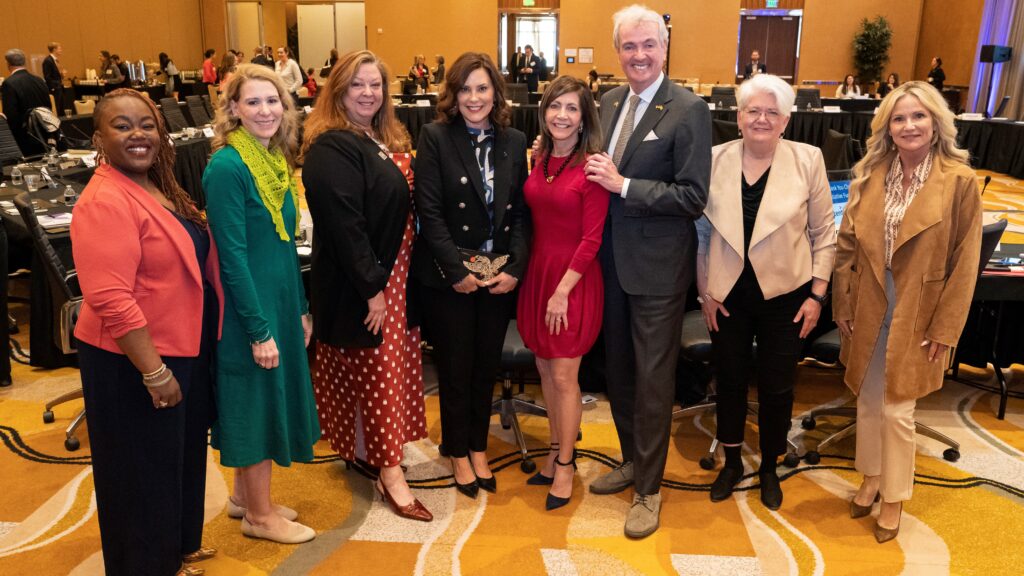The third roundtable of the New Jersey First Lady Tammy Murphy’s Initiative on maternal and infant health took place in Detroit, Michigan, presided by New Jersey Governor Phil Murphy and Michigan Governor Gretchen Whitmer.

The roundtable identified the barriers for mothers and families seeking care and surfaced opportunities for states and health systems to mitigate challenges, ensuring better access to high quality care for moms and babies. This discussion brought to light issues related to maternity care quality improvement initiatives in states, work to further grow and diversify the perinatal workforce to create the access to the types of care that families are seeking, and the importance of access to wholistic maternity care that includes mental health, physical health, and the social determinants of health. This is the third in the series of four roundtables occurring over the first half of 2023.
The roundtable discussion on Expanding Access and Quality of Care raised eight key themes:
Quality Care Includes Addressing Obstetric Racism
Black women are three times more likely to die from a pregnancy-related cause than White women. Multiple factors contribute to these disparities, including structural racism and implicit bias. Accountability for BIPOC deaths has spurred new approaches. One new, validated measurement tool that has been developed to counter obstetric racism is called The PREM-OB Scale™. The PREM-OB Scale examines obstetric racism, as defined for, by, and with Black mothers and Black birthing people, during hospitalization for labor, birth, and postpartum in six theorized patient identified quality of care domains: Safety, Autonomy, Communication, Racism, Empathy, and Dignity = SACRED. Nineteen hospitals across ten states are currently registered as partners in implementing this innovative approach which was only validated in 2022.
Culturally Reverent Workforce Pipelines and Access to Capital
As states begin to cover the costs for doulas and community support workers, reimbursement for midwives, and licensure for birth centers, states need to consider the birth workforce pipeline. These policies help create the potential for a more diverse and layered workforce, but the reimbursement policy changes alone will not create the pipeline of workers to fill these roles. States can support the expansion of midwifery schools, scholarships for doula and peer support training programs, mentoring and recruitment outreach, and also access to capital to build more accredited birthing centers. The roundtable attendees discussed the possibility of Historically Black Colleges and Universities creating programs for these birth workforce models. Certified nurse midwives, substance use disorder workforce, and midwives in rural health care are all eligible categories for the federal HRSA student loan repayment programs.
Midwifery and Free-Standing Birth Centers
States are starting to reimburse two distinct types of midwifery care for births* and are starting to allow the establishment of free-standing birth centers. The freestanding birth center is defined as a facility where birth is planned to take place away from the hospital and away from the person’s residence, where care is provided in the midwifery and wellness model, with birth center care integrated into the healthcare system. Over the past 40 years, the number of birth centers in the United States has grown to more than 400 as of 2021. The number of births in birth centers has doubled over the past 10 years and was almost 20,000 in 2019. This represents only .5% of annual births in the United States.
* Certified Nurse-Midwives (CNM) and Certified Midwives (CM) are trained in both nursing and midwifery. The training is hospital-based, and the vast majority of CNMs practice in clinics and hospitals. Although their training occurs in medical settings, the CNM/CM scope of practice allows them to provide care in any birth setting. Certified Midwives (CM), sometimes referred to as Direct Entry Midwives, are individuals who have or receive a background in a health-related field other than nursing, then graduate from a masters level midwifery education program. They have similar training to CNMs, conform to the same standards as CNMs, but are not required to have the nursing component.
Reducing Cesarean Rates
Cesarean births, births via surgical intervention, have increased in countries around the world, now accounting for more than 1 in 5 of all childbirths. On average, in the United States in 2021, 32.1% of live births were cesarean deliveries; Utah has one of the lowest cesarean rates at 23.4% of all births, Alabama has the highest at 35.1%. Eliminating the overuse of cesarean births and promoting, protecting, and supporting vaginal births is an important goal around maternal mortality and morbidity. Since most people are healthy enough when becoming pregnant, the system incentives need to be changed to eliminate overuse of cesarean births and promote, protect, and support vaginal births.
Blending Traditional and Western Medicine
According to a National Indian Health Board (NIHB) report, indigeneity is the number one social determinant of health. There are some Indigenous regions that are creating a hybrid of the best western medicine has to offer alongside traditional medicine, including allowing traditional healers to practice alongside doctors with permissions from the hospitals. For example, in Detroit, Michigan, The American Indian Health and Family Services clinic is adopting this type of model.
Earlier Postpartum Care
Current practice typically creates a gap in care between delivery and a postpartum obstetric visit of six weeks. This is a vulnerable time and one where perinatal mood and anxiety disorders can quickly take hold along with physical health complications. Universal home visits conducted by pregnancy and postpartum doulas bridge this critical gap in care. NJ is one of several states implementing a universal home visiting program.
Paid Family Leave
States should support the evidence behind paid family leave policies. The Prenatal-3 Policy Center notes that state paid family leave programs can improve the economic security of the family and keep parents engaged in the workforce. The programs help new parents have more time to bond with their babies, develop positive caregiving skills, and build the foundation for healthy attachment. Further, parents may be better able to seek timely and preventative health care for themselves and their children.
Perinatal Mood and Anxiety Disorders
This roundtable emphasized the importance of addressing perinatal mood and anxiety disorders and perinatal substance misuse. According to 2022 CDC data, the leading underlying causes of pregnancy-related death include:
- Mental health conditions (including deaths to suicide and overdose/poisoning related to substance use disorder) (23%)
- Excessive bleeding (hemorrhage) (14%)
- Cardiac and coronary conditions (relating to the heart) (13%)
Perinatal mental health and substance use disorders are the most common complication in pregnancy, affecting one in five women, and one that carries significant, long-term impact. Mathematica research published in 2019 and led by Dr. Kara Zivin who presented at the roundtable, estimated that the total societal cost of untreated PMADs in the U.S. is $14.2 billion for just the total births in 2017 (one year) when following the mother-child pair from pregnancy through five years postpartum. It is important to require screening and build a continuum of care to treat both perinatal mood and anxiety disorders and substance use disorders. Currently, only 11 states require maternal depression screening through Medicaid. Screening is only the beginning to ensure that perinatal behavioral health concerns are monitored and more fully explored. The continuum of care to support treatment to remission for women with mild to severe symptoms as well as providing prevention needs more attention. One success is the number of states that are starting tele-psychiatry consultation programs in this space to give front-line providers real-time access to the most highly trained reproductive psychiatrists in the state. These programs are typically started with funding from HRSA and then sustained through a mix of state funding and fee-based structures. The original program and model for most states is called McPAP for Moms in Massachusetts.
A Note on Language: This report uses the phrase “maternal and infant health” to refer to the health of individuals with the capacity to become pregnant, regardless of gender identity, and their biological infants. We do not assume that all individuals giving birth will care for that child, so the report refers to caregivers, partners, and spouses.












